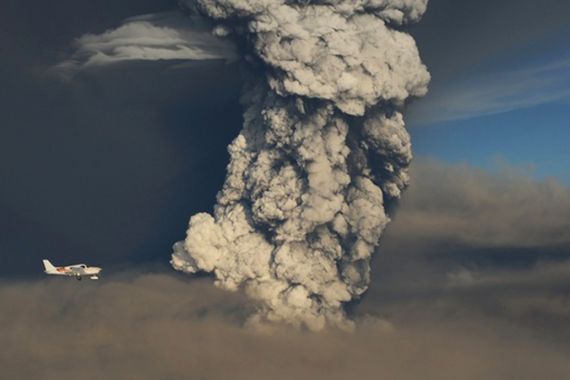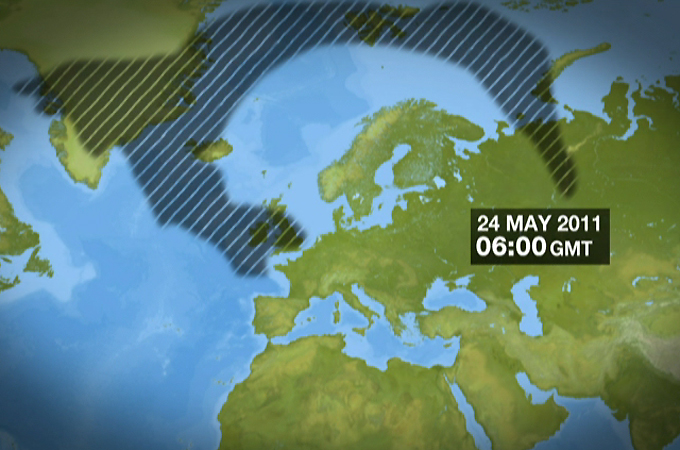Ash cloud disrupts Europe travel
Hundreds of European flights are cancelled as ash from Iceland’s erupting volcano spreads further east.

The spread of dense ash from the erupting Iceland volcano could force the cancellation of up to 500 commercial flights in Northern Ireland, Scotland and parts of Scandinavia, the European air traffic agency has said.
Between 200 and 250 flights had already been cancelled, Brian Flynn, head of network operations at Eurocontrol, said on Tuesday.
Keep reading
list of 4 items‘Mama we’re dying’: Only able to hear her kids in Gaza in their final days
Europe pledges to boost aid to Sudan on unwelcome war anniversary
Birth, death, escape: Three women’s struggle through Sudan’s war
Britain’s weather service said it appeared that ash from the Grimsvotn volcano had reached Scottish airspace and could affect other parts of the UK and Ireland later in the week.
“All the data we are receiving confirms our forecasts, that there is high-density ash over Scotland,” Barry Grommett, a spokesman, said.
British Airways suspended all its flights for Tuesday morning between London and Scotland, while Dutch carrier KLM and Easyjet cancelled flights to and from Scotland and northern England at the same time.
Scottish regional airline Loganair cancelled 36 Scottish flights scheduled for Tuesday morning, as well as some flights to Birmingham and Belfast. It said its flights between Scottish islands would be unaffected.
Two other British regional airlines, Flybe and Eastern Airways, also cancelled flights to and from Scotland on Tuesday.
Ash cloud risk challenged
But the disruption has angered airline Ryanair, which said it had sent its own airplane into Scottish airspace and found no ash in the atmosphere.
“Exactly as we predicted, we encountered absolutely no problems,” its chief executive Michael O’Leary told the AP news agency.
“There’s no cloud over Scotland. There’s no dusting of ash on the airframe or the wings. The airspace over Scotland should never have been restricted in the first place.”
But other airlines were more willing to follow official advice. Declan Kearney, spokesman for Aer Lingus, said it had canceled 20 flights between Ireland and Scotland.
“We have no reason to question the advice being given to us by the aviation authorities at this time. We need to accept what the experts in this area are telling us,” he said.
Rory Challands, Al Jazeera’s correspondent in London, said that most of the ash is going north into the Artic but there is a southern spur moving into Scotland, Northern Ireland and parts of Scandinavia.
 |
| Icelandic ash cloud spreads to UK and Scandinavia |
“Norway has restricted flight services as the cloud makes its way to Scandinavia and Denmark has closed part of its airspace,” he said.
“Scotland is the worst affected at the moment. Most of the airports there have had a great many flights into and out of them cancelled.
“Weather maps from the UK met office have shown by midnight GMT tonight there will be some ash over London, but it will probably be quite low concentrations and may not have any impact on flights.
“The cloud may travel into France and other parts of Europe by about Thursday, but we will have to wait and see.”
Andrew Haines, chief executive of the CAA, said the first priority was ensuring the safety of people both onboard aircraft and on the ground.
Improved procedures
However, authorities said they did not expect the kind of massive grounding of flights that followed last year’s eruption of the Eyjafjallajokull volcano in Iceland. Systems and procedures had been improved since then, they said, and the cloud is currently not expected to move over continental Europe.
Many airlines said authorities last year overestimated the danger to planes, and overreacted by closing airspace for five days amid fears that the abrasive ash could cause engines to stall.
CAA spokesman Jonathan Nicholson said authorities this time would give airlines information about the location and density of ash clouds. Any airline that wanted to fly would have to present a safety report to aviation authorities in order to be allowed to fly.
He said most British airlines had permission to fly through medium-density ash clouds, but none had asked for permission to fly through high-density clouds, classified as having over 4,000 micrograms of ash per cubic metre.
Even at that concentration of volcanic ash, experts said the air would not look much different from airspace unaffected by the ash, but officials say the tiny particles in the ash can sandblast windows and stop jet engines.
However, the international pilots’ federation warned that it believed the cloud still presented a potential danger to commercial aircraft despite developments since last year.
“It remains our view that when there is an unknown then it is always better to err on the side of caution,” Gideon Ewers, spokesman for the International Federation of Air Line Pilots’ Associations, said.
Barnaby Phillips, Al Jazeera’s correspondent in the Icelandic capital, Reykjavik, spoke to meteorologists who said the volcano’s activity had slowed.
“The good news is that the volcano seems to be losing strength,” he said.
The ash plume dropped from its peak of 20 km to between three and five kilometres in altitude. The bad news is that there is an awful lot of ash already up there in the atmosphere.”